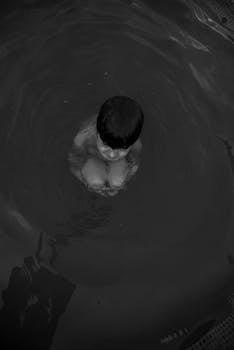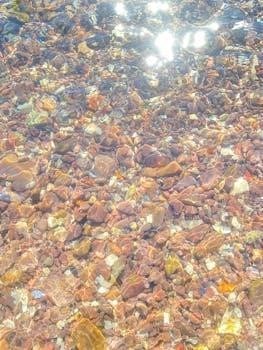Embarking on an above ground pool installation brings summer fun closer to home. This guide simplifies the process, providing essential steps for a successful setup and lasting enjoyment.
Why Choose an Above Ground Pool?
Above ground pools offer a compelling alternative to in-ground options, presenting a blend of affordability, ease of installation, and flexibility. Their cost-effectiveness makes the dream of pool ownership accessible to a wider range of homeowners, bypassing the significant expenses associated with excavation and extensive landscaping.
Installation is notably simpler and quicker; many models can be assembled in a weekend with the right tools and a helping hand. This contrasts sharply with the weeks or months required for in-ground pool construction. Furthermore, above ground pools are not permanent fixtures, offering the freedom to relocate or disassemble the pool if your needs change.
They come in various shapes and sizes, catering to different backyard spaces and aesthetic preferences. Maintenance is generally straightforward, and safety features like removable ladders provide added security. For those seeking a convenient and budget-friendly way to enjoy the pleasures of swimming, an above ground pool is an excellent choice.
Safety First⁚ Pre-Installation Considerations
Prioritizing safety before installing your above ground pool is paramount to prevent accidents and ensure a secure environment for everyone. Begin by thoroughly checking local regulations and homeowner association rules regarding pool installations, including fencing requirements, setback distances, and permit procedures. Familiarize yourself with these guidelines to avoid potential fines or legal issues.
Next, carefully inspect the intended installation site for underground utilities such as gas lines, electrical cables, and water pipes. Contact your local utility companies to mark the locations of these lines to prevent damage during ground preparation. This step is crucial to avoid potentially hazardous situations and costly repairs.
Consider the pool’s proximity to overhead power lines, ensuring a safe distance to prevent electrical hazards. Keep the pool area free from obstructions and potential tripping hazards. Finally, plan for appropriate safety measures like fencing, self-latching gates, and pool alarms to restrict unauthorized access and protect children and pets.

Planning Your Pool Installation
Careful planning is essential for a smooth above ground pool installation. This section outlines crucial steps, ensuring proper site selection and gathering necessary tools for the project.
Selecting the Right Location
Choosing the perfect spot for your above ground pool is a decision that impacts both enjoyment and longevity. Begin by assessing your yard’s overall layout, considering factors like sunlight exposure, proximity to trees, and underground utilities. Ideally, the pool area should receive ample sunlight throughout the day to naturally warm the water and minimize the growth of algae.
Avoid placing the pool directly beneath trees, as falling leaves and debris can quickly clutter the water and necessitate more frequent cleaning. Furthermore, tree roots can potentially damage the pool liner or structure over time. Before committing to a location, contact your local utility companies to identify and mark any underground lines or pipes. This step is crucial for safety and prevents accidental damage during the installation process.
Also, consider the visual impact and accessibility of the pool area from your house. Aim for a location that complements your landscape and allows for easy supervision, especially if children will be using the pool. Finally, check for any local ordinances or homeowner association rules that might dictate pool placement or fencing requirements.
Essential Tools and Materials Checklist
Before commencing your above ground pool installation, gathering the necessary tools and materials is paramount. A comprehensive checklist ensures a smooth and efficient process. Start with essential tools like a shovel, level, measuring tape, and a wheelbarrow for moving materials. A sod cutter might be needed for removing grass, and a tamper will help compact the ground.
For assembly, you’ll require wrenches, screwdrivers (both Phillips head and flathead), and possibly a rubber mallet. Ensure you have a utility knife for opening boxes and trimming the liner. Safety glasses and work gloves are crucial for personal protection throughout the installation.
Regarding materials, the obvious is the pool kit itself, which includes the pool frame, liner, and skimmer. You’ll also need sand for creating a smooth base (optional but recommended), pool cove (also optional but improves liner longevity), and plumbing fittings for connecting the pump and filter. Don’t forget a garden hose for filling the pool, and test strips for water chemistry adjustment post-fill.

Preparing the Ground
Proper ground preparation is crucial for a safe and long-lasting above ground pool. This stage involves leveling the site, removing debris, and ensuring a solid foundation.
Leveling the Site⁚ A Step-by-Step Guide
Leveling the ground is arguably the most critical step in above ground pool installation. An unlevel base can lead to structural issues, uneven water distribution, and potential pool collapse. Start by clearing the chosen area of all vegetation, rocks, and debris. Use a shovel and rake to roughly level the surface.
Next, drive a stake into the center of the area. Attach a string to the stake and tie the other end to a line level. Rotate the string around the stake, checking the level at various points along the circumference. Mark any high spots that need to be lowered and low spots that need to be filled.
Remove soil from the high spots and add it to the low spots, compacting the soil as you go. Regularly check the level with the string and line level. Continue this process until the entire area is perfectly level. Accuracy is paramount; take your time and double-check your work. A properly leveled site ensures a stable and enjoyable pool for years to come.
Adding a Sand Base (Optional)
While not always necessary, adding a sand base beneath your above ground pool offers several advantages. A sand base provides a smooth, comfortable surface for the pool liner, preventing punctures and reducing wear and tear. It also aids in leveling any minor imperfections that may remain after the initial ground preparation.
Use clean, fine sand, free of rocks and debris. Spread the sand evenly over the leveled area, creating a layer approximately 2-3 inches thick. Use a rake to distribute the sand uniformly, ensuring there are no high or low spots. A concrete mixing float can be used to further smooth and compact the sand.
Lightly dampen the sand with water; this helps it to compact and hold its shape. Avoid over-saturating the sand, as this can create mud. Once the sand is evenly spread and compacted, check the level again to ensure it remains consistent across the entire surface. A well-prepared sand base will significantly extend the life of your pool liner and enhance your swimming experience.

Assembling the Pool Frame
With the ground prepared, focus shifts to the frame; Follow the manufacturer’s instructions carefully. Correct assembly ensures structural integrity and a safe swimming environment for everyone.
Connecting the Bottom Rails
The bottom rails form the foundation of your above ground pool, so precision is key during this stage. Start by laying out all the bottom rails around the perimeter of the prepared pool area, ensuring they are oriented correctly according to the manufacturer’s diagrams. Most kits use a system of connecting plates or sleeves to join the rails together.
Carefully slide the rails into these connectors, making sure they are fully seated and aligned. It’s often helpful to use a rubber mallet to gently tap the rails into place if they are a tight fit. As you connect each rail section, double-check that the entire circle or oval is taking shape according to the pool’s design.
Pay special attention to the corners or curves of the pool, where the rails may need to be slightly flexed or adjusted to achieve the correct shape. Use a level periodically to ensure the rails are staying horizontal as you progress. This prevents uneven weight distribution later on.
Once all the rails are connected, inspect the entire bottom rail assembly for any gaps or misalignments. Tighten all screws or bolts on the connectors securely, but avoid over-tightening, which could damage the components. The connected bottom rails should form a solid, continuous base for the rest of the pool structure.
Installing the Uprights and Top Rails
With the bottom rails securely in place, it’s time to erect the pool’s uprights, providing vertical support. Position each upright carefully onto the bottom rails, ensuring they are properly aligned with the pre-drilled holes or designated slots. Secure the uprights to the bottom rails using the provided screws or bolts. Tighten them firmly, creating a stable connection.
Next, prepare the top rails, which will connect the uprights and form the pool’s upper perimeter. Carefully place the top rails onto the uprights, aligning the holes. Some models might require you to use connector plates to join the top rails together.
Once the top rails are in position, secure them to the uprights using screws or bolts. Tighten them gradually, ensuring that the rails are evenly distributed and aligned. As you tighten the screws, double-check that the entire structure is level and stable.
Make sure all connections are snug and secure, but avoid over-tightening, which can damage the components. A well-connected top rail and upright system contributes significantly to the pool’s structural integrity and overall appearance; After installation, inspect every joint again.

Installing the Pool Liner
Installing the pool liner correctly is crucial for a leak-free and smooth swimming experience. This section covers proper placement techniques and how to eliminate wrinkles and creases.
Proper Liner Placement Techniques
Proper liner placement is paramount to achieving a smooth, wrinkle-free pool surface. Before unfolding your liner, ensure the pool floor is clean and free of any sharp objects that could puncture it. Carefully center the liner within the pool, aligning the seam with the upright supports where possible.
Start by gently draping the liner over the pool wall, securing it temporarily with coping strips or liner clips. The goal is to evenly distribute the material, avoiding excessive stretching or bunching in any one area. Work your way around the pool, making small adjustments to ensure the liner sits snugly against the wall.
Once the liner is generally in place, begin smoothing it out from the center towards the edges. This helps to eliminate air pockets and prevent wrinkles from forming. Use a soft brush or your hands to gently massage the liner into the corners and along the pool floor. Patience is key here; take your time to achieve a smooth, even fit. Avoid using sharp objects or excessive force, as this could damage the liner. Remember, a well-placed liner is essential for the longevity and enjoyment of your above-ground pool.
Smoothing Out Wrinkles and Creases
After initial liner placement, addressing wrinkles and creases is crucial for a pristine pool finish. Begin by identifying the areas with the most prominent imperfections. Often, wrinkles originate from uneven stretching or air trapped beneath the liner.
A helpful technique involves using a soft-bristled brush to gently push the wrinkles towards the pool walls as you slowly introduce water. Start filling the pool with just a few inches of water, allowing the liner to settle and conform to the pool’s shape. As the water level rises, continue smoothing out the wrinkles, working from the center outwards.
For stubborn creases, try using a plunger (specifically a sink plunger, not a toilet plunger) to gently suction and reposition the liner. Apply slight pressure and work in small sections. Avoid using sharp objects or excessive force, as this could puncture or tear the liner. Patience is essential; it’s a gradual process.
If wrinkles persist even after the pool is partially filled, consider carefully adjusting the liner’s position by releasing the coping strips slightly and re-stretching the material. Remember, a smooth liner not only enhances the pool’s appearance but also prolongs its lifespan.
Final Steps and Filling the Pool
With the pool assembled and the liner in place, it’s time for the finishing touches. This involves connecting the filtration system, filling the pool, and starting the initial water treatment.
Connecting the Pump and Filter System
The pump and filter system are the heart of your pool’s cleanliness. Proper connection ensures clear, safe water for swimming. Begin by carefully reading the manufacturer’s instructions for your specific model. Identify the inlet and outlet ports on both the pump and the pool. Use Teflon tape on all threaded connections to prevent leaks. Attach the hoses securely with clamps, ensuring a tight seal. The pump should be placed on a level surface near a GFCI-protected electrical outlet.
Prime the pump by filling it with water according to the manufacturer’s directions, which expels air from the system allowing it to operate efficiently. Once primed, plug in the pump and observe for any leaks or unusual noises. Check the water flow and ensure it’s circulating correctly. The filter should be backwashed initially to remove any debris from the filter media. Regularly inspect the connections and the filter pressure gauge to maintain optimal performance and water quality.
Filling the Pool and Initial Water Treatment
With your pool assembled and the pump connected, it’s time to fill it with water. Use a garden hose to slowly fill the pool, carefully monitoring the liner for any shifting or wrinkles. Avoid filling the pool too quickly, as this can put stress on the structure. Once the pool is full, it’s crucial to balance the water chemistry.
Begin by testing the pH, alkalinity, and calcium hardness levels using a water testing kit. Adjust these levels as needed, following the instructions on your pool chemicals. Add a chlorine or saltwater solution to sanitize the water, preventing algae growth and bacteria. Run the pump and filter system continuously for at least 24 hours to circulate the chemicals and ensure proper distribution. Retest the water after 24 hours and make any necessary adjustments to maintain a healthy and enjoyable swimming environment. Regularly clean the pool and maintain the water’s chemical balance.
